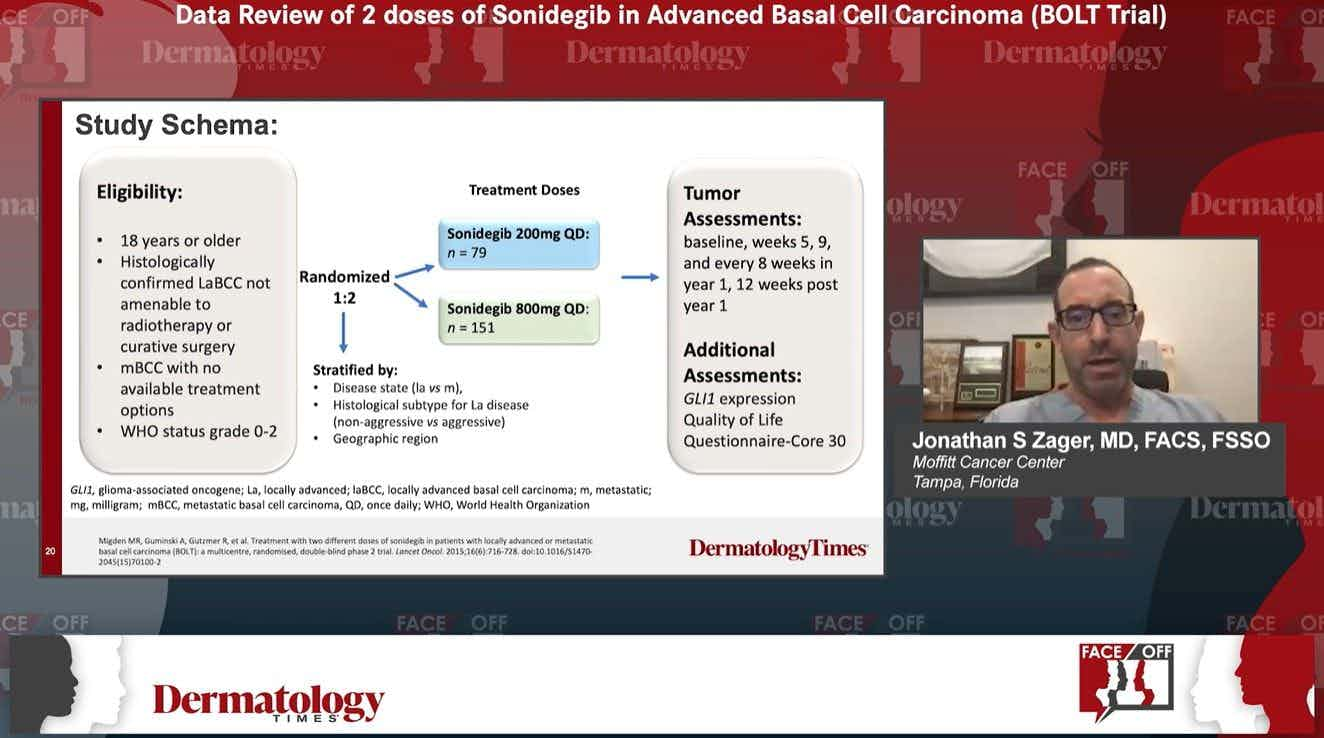- Acne
- Actinic Keratosis
- Aesthetics
- Alopecia
- Atopic Dermatitis
- Buy-and-Bill
- COVID-19
- Case-Based Roundtable
- Chronic Hand Eczema
- Drug Watch
- Eczema
- General Dermatology
- Hidradenitis Suppurativa
- Melasma
- NP and PA
- Pediatric Dermatology
- Pigmentary Disorders
- Practice Management
- Precision Medicine and Biologics
- Prurigo Nodularis
- Psoriasis
- Psoriatic Arthritis
- Rare Disease
- Rosacea
- Skin Cancer
- Vitiligo
- Wound Care
Article
Systemic option for squamous cell carcinoma
Author(s):
A new systemic medication option offers promising results for patients with high-risk squamous cell carcinoma for whom surgery has not worked, says this expert.
A new systemic medication option offers promising results for patients with high-risk squamous cell carcinoma for whom surgery has not worked, according to Chrysalyne Schmults, M.D., associate professor of dermatology at Harvard Medical School and vice chair of surgical oncology at Brigham and Women’s Hospital dermatology department, Boston. An intravenous, programmed death receptor-1 inhibitor drug called cemiplimab (Libtayo, Sanofi and Regeneron Pharmaceuticals) could offer a long-term halt of disease for a significant number of patients with this disease.
RELATED: Advances in squamous cell carcinoma management
“We’ve gone for so many years, in fact, the entire history of squamous cell carcinoma without an FDA-approved treatment for people who fail surgery and radiation,” she says. “We’ve been in dire need of a good treatment option for when patients become unresectable. Now, we have a drug with a 50% response rate, and that’s a big improvement for these patients.”
This therapeutic advancement is significant, she says, because squamous cell carcinoma kills approximately the same number of patients annually as melanoma. But, until now, patients have only received an EGFR antagonist or platinum-based chemotherapy after an unsuccessful surgery or radiation. Efficacy for these options is short term and only occurs in roughly 20% of patients.
For appropriate patients, the cemiplimab dose is 350mg every three weeks. Each infusion session lasts 30 minutes. Although the dermatologist is likely the first provider to identify and diagnose squamous cell carcinoma, a medical oncologist will typically administer the medication in the United States, Dr. Schmults says. Still, it is important for dermatologists to be aware of the drug and to become familiar with its impact and side effects, especially since these drugs will likely be combined in the future with drugs that will be injected directly into tumors by dermatologists.
RELATED: Radiotherapy for squamous cell carcinomas
Few dermatology centers nationwide are equipped to deliver cemiplimab, but providers who wish to assume a more active role with the medication could pursue treatment privileges at an infusion center with appropriate safeguards and nursing support for intravenous systemic therapy, she says. Additional education is currently available via the European Academy of Dermatologic Oncology.
“I suggest that dermatologists who are interested in learning more about cemiplimab and participating in this aspect of patient care should talk to people in their community who have experience with immunotherapy,” she says.
RELATED: Diet may impact squamous cell carcinoma risk
Alongside its 50% efficacy rate, cemiplimab does produce some side effects. The most common are rash, fatigue and diarrhea. Less common, but still possible, are pneumonitis, colitis, and hepatitis, occurring in approximately 2.4%, 0.9%, and 2.1% of patients, respectively. For most of these cases, Dr. Schmults says, oral prednisone is the main treatment. When these problems occur, cemiplimab is sometimes discontinued temporarily. In more severe cases, though, it may be discontinued permanently and hospitalization may be needed. The American Society of Clinical Oncology has published guidelines for how to handle immune-related toxicities of immunotherapy drugs like cemiplimab.
Most of cemiplimab’s side-effects are due to overstimulation of the immune system, which can impact any organ in the body. And, in some cases, the effect can be permanent. For example, Dr. Schmults says, the medication frequently affects the thyroid, producing either hypothyroidism, treated with levothyroxine or hyperthyroidism. A patient could also develop permanent diabetes if autoimmune pancreatitis is present.
Dr. Schmults cautions that cemiplimab is not safe for all patients with squamous cell carcinoma. If a patient has received an organ transplant or has an immune-mediated disease, such as severe lupus, this medication may not be an option. In those cases, a dermatologist should consult with other members of the patient’s healthcare team to determine the best path forward for treatment.
RELATED: Genetic expression profiling for squamous cell carcinoma
Ultimately, Dr. Schmults says, it’s important for dermatologists to be aware of this treatment option when surgery fails. Knowing how to combine existing and future treatments with intravenous systemic therapies, particularly cemiplimab, will be vital to patient management.
“As providers, dermatologists should know this drug approach is available for patients who have exhausted the other curative methods of surgery and radiotherapy,” she says. “There really isn’t another option right now.”
Newsletter
Like what you’re reading? Subscribe to Dermatology Times for weekly updates on therapies, innovations, and real-world practice tips.















